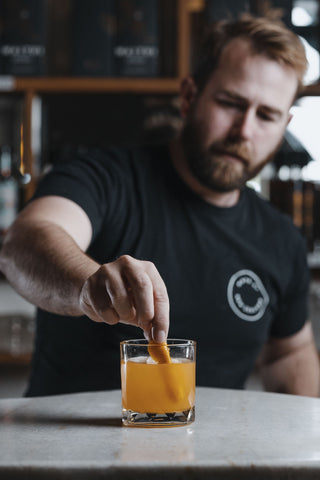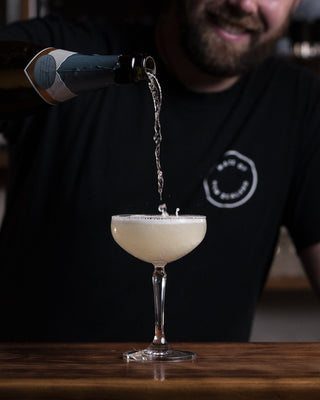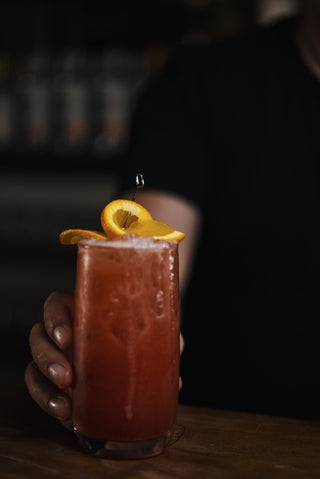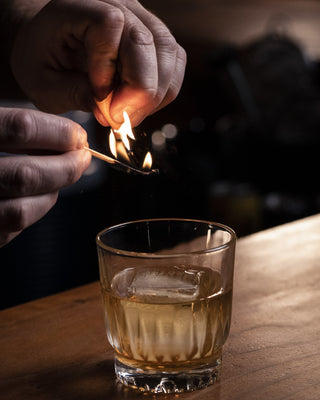
Seven Techniques for Cocktail Perfection
Crafting the perfect cocktail is an art form that combines creativity, precision, and a dash of flair. Whether you're hosting a lively gathering or simply enjoying a quiet evening at home, mastering a few key tips can elevate your drink making game from ordinary to extraordinary. From the zesty brightness of freshly squeezed citrus to the meticulous choice of garnishes, each element plays a crucial role in creating a memorable cocktail experience. Ready to shake up your skills? Let's dive into the secrets that will make your cocktails not just good, but exceptional.
1. FRESH CITRUS IS ALWAYS BEST
Citrus is just as important as the quality of spirits. Fresh citrus influences the brightness and freshness of your drink, which result in a much better drinking experience.
Unlike store bought juices, fresh citrus contains essential oils from the zest as well as natural enzymes in the flesh, which contribute to a brighter, more aromatic ingredient.
A good example is how the amount of citric acid and sugar in each type of citrus changes dramatically and determines how we perceive the overall flavour of the cocktail. Oranges are lower in citric acid but higher in sugar, so taste sweeter, however limes are higher in citric acid and lower in sugar, so we taste far more sour notes.
Using fresh citrus in cocktails is crucial to make the best quality drink to ensure each sip is refreshing and enjoyable to you and your guests.
Key Tips:
- Use a handheld juicer to get the most out of your citrus.
- Meyer Lemons are perfect for cocktail making, they have the perfect mix of sweet and acidic.
2. TASTE, TASTE AND TASTE AGAIN
Get into the habit of tasting all your cocktail ingredients individually each time, by tasting lots of different flavours you will gain a more refined palate. This will help you identify the key flavour profile of each element in a cocktail so you can recreate cocktails you enjoy out at restaurants once your back at home. It will also help you to better understand exactly what it is about each cocktail that you like and dislike.
Even minor variations in ingredient measurements or quality can affect the final taste, so it is also very important to taste your cocktails before serving.
This ensures that your cocktail consistently achieves your desired balance of flavours and meets the same high quality over and over again. This step allows you as the bartender to adjust the flavours, for the perfect mix of sweetness, acidity, bitterness, and alcohol.
Key Tips:
- Although you would most commonly taste your drinks before serving them, it is never too late to readjust a cocktail.
- A polite way to sample your drink is to use a straw; you can do this by placing the straw into the liquid then placing your finger or thumb over the end of the straw creating an airtight seal. This allows you to place the other end of the straw in your mouth or over your anatomical snuffbox behind your thumb and drink your sample from there.
3. A COCKTAIL WITHOUT A GARNISH IS JUST A DRINK
A great garnish will make your cocktail more inviting, vibrant, fun and visually appealing. The absence of garnishes can likewise take a lot away from it too.
This visual element sets the mood and elevates the drinking experience, making it more enjoyable and memorable. Whether it’s a twist of lemon, a sprig of mint, or a stick of cinnamon; a garnish entices the senses even before the first sip.
Beyond aesthetics, garnishes also play a functional role in enhancing the flavour and aroma of the cocktail. Many garnishes, like citrus peels, fresh herbs, or even spices, release essential oils and aromas that complement and enhance the drink’s flavour profile. For example, a sprig of rosemary or a twist of orange peel can add a fragrant, aromatic note that elevates the complexity of the cocktail. Additionally, garnishes can provide a tactile element, inviting the drinker to engage more deeply with the beverage through scent and touch. This multisensory experience not only heightens enjoyment but also reflects the thoughtfulness and craftsmanship behind each cocktail.
Key Tips
- A wedge of lemon or lime is a great garnish, not just a aesthetic component but also can add a little extra acid and flavour to your drink should you want it.
- Some garnish options are: limes, lemons, oranges (peels or slices), rosemary, cinnamon, mint, olives, cucumber or even salt.
- Always spank the mint!
4. BREAKDOWN OF EQUIPMENT
You certainly don’t need all the fancy tools, just a few essentials are a good investment to start on this journey.
When making cocktails, it’s good practice to have your tools close at hand. It creates the right mood and atmosphere for you and makes the process easier too. Using the correct equipment when making a cocktail is essential for achieving precision and consistency in every drink. Each tool, from shakers and strainers to jiggers and muddlers, is designed to perform specific tasks that contribute to the perfect balance and texture of a cocktail.
For instance, a jigger ensures that you get an accurate measure of spirits and mixers, preventing over, or under, pouring, which will disrupt the intended flavour profile. A jigger is the most important piece of equipment you can buy as free pouring after a couple of cocktails is downright dangerous.
A shaker, on the other hand, is vital for properly mixing and chilling ingredients, making sure that all components are thoroughly combined. A Boston Shaker, sometimes called a Tin on Tin Shaker, is the industry preferred shaker as it is easier to use and also holds more liquid, meaning you can make two drinks at once.
There are two different strainers you can use when making cocktails. One is a Hawthorne strainer which goes inside your shaker when you are pouring and stops large pieces of ice, fruit, or other ingredients being poured into your glass. The other is a fine strainer and looks just like a small sieve, this strainer helps achieve a smooth pour without unwanted ice shards or fruit pulp.
Glassware compliments the cocktail’s style and will enhance its visual appeal. Something important yet often overlooked when making cocktails at home is ensuring you use the correct glassware - consider being served a martini in a brandy snifter. A martini glass is shaped the way it is to ensure the drink stays cold; by holding the glass by its stem, we ensure the warmth of our hands is not transferred through the glass into the drink. Alternatively, serving brandy in a martini glass we get the opposite effect, were we want the warmth of our hands to radiate into the drink through the glass, but the inherent nature of the martini glass means this does not happen. Its not exactly a hard rule but choosing the correct glass will have an immediate effect on your drink, from how we garnish it, the aroma, to how long it stays cold.
Key Tips
- Fill the shorter end of your shaker first then place the larger side on top. This will avoid filling your shaker up to much and not being able to create a good seal, potentially spilling your drink. The golden rule is to pour into the small side and pour out of the large.
- The basic equipment you need is a jigger, shaker and a strainer. Some extras you might like to get are a large mixing glass, long stemmed stirring spoon and quality appropriate glassware.
5. THE IMPORTANCE OF ICE
You simply cannot make a great cocktail without ice. It's important to use good quality ice cubes and get the ratio of ice correct in your cocktails.
A good ice cube should be large, cold, hard, solid, and dry; and if possible stored in a drainable container so the ice isn’t sitting in meltwater. Using quality ice in cocktail making is important because it affects both the taste and presentation of the drink. High quality ice, which is clear and free of impurities, chills the cocktail more effectively without introducing unwanted flavours or odours. Clear ice, in particular, melts more slowly than cloudy or dirty ice, ensuring that the drink is properly chilled while minimizing dilution. This slow melting helps maintain the intended balance of flavours, preventing the cocktail from becoming watered down too quickly, which can compromise its overall quality and enjoyment.
It is also very important when making a built cocktail (a cocktail made in the glass it is served in like a gin and tonic for example) that you fill your glass to the top with ice. Never ever just a couple of lonely ice cubes as without a full glass of ice the cocktail wont cool efficiently and you’ll need to add too much mixer to fill your drink to the top resulting in a “drowned” cocktail which will taste watered down.
The size and shape of the ice can impact the drink’s texture and visual appeal. Large, well-formed ice cubes are often preferred when making and serving cocktails because they provide a slower, more controlled melt. When shaking or stirring your cocktail, large ice cubes allow the drink to become cold faster without excessive dilution, alternatively when serving your drink, the ice melts slower, keeping your drink colder for longer without excessive melting, meaning you can savour your creations.
Key Tips
- When buying store brought ice, look for solid pieces of ice. Some brands make their ice with a hole in the middle because its faster for them to produce. This ice is the last ice we want to use for drink making as it melts very quickly, resulting it a cold but watery drink.
- Invest in a large format ice cube tray for making your drinks at home. This allows you to not only have perfect ice on hand, but you can also add things to the ice like
flowers to bring your drinks to life. - You can make clear ice at home by cleaning out your jug, and boiling distilled water, then pour your boiled water into your ice cube tray and freeze. The reason you should clean your jug and use distilled water is to make sure there are no impurities in the ice. It may take a bit of practise to get right.
6. BY FAILING TO PREPARE, YOU ARE PREPARING TO FAIL
Proper preparation is fundamental for any bartender; it ensures efficiency and consistency, which are crucial for delivering high-quality drinks.
Preparing ingredients in advance, such as cutting garnishes, squeezing fresh juices, and organizing tools allows you to work swiftly and effectively, especially when entertaining guests. This approach ensures that every component is ready and accessible, minimizing delays and errors. Consistent preparation also means that each cocktail is made to the same high standard, impressing your guests every time and showcasing your skills.
When properly prepared, you can focus on the finer details of cocktail creation, giving you more time to taste and adjust your drinks, making sure the correct flavours are coming through, and giving you more time to perfect the presentation of your drinks, making each drink that little bit more special.
Key Tips:
- Citrus juice will lose its freshness after around 10 hours, this gives lots of time to pre squeeze your citrus juice and store in the fridge until ready. However, If you have left over juice, you can store it in the fridge for up to 3 days with a slight reducing in its brightness.
- Sugar syrup is a key ingredient in most cocktails, easily made in a 2:1 ratio. Simply mix 2 parts sugar to 1 part boiling water and stir until dissolved. Works great stored in an empty gin bottle and doesn’t need to be in the fridge.
7. AND FINALLY, QUALITY INGREDIENTS
Using quality ingredients when making cocktails is vital because it directly impacts the flavour, aroma, and overall experience of the drink.
Good quality spirits, fresh fruits, garnishes, and mixers bring out the best in a cocktail, ensuring that each sip is rich and well-balanced. Inferior ingredients can introduce off-flavours, dull the cocktail's vibrancy, and undermine the careful work put into creating your perfect cocktail.
Above we talk about ice and how its influence on all parts of drink making. This holds true for all ingredients we use. A good example being fresh fruit — fresh-squeezed citrus juice has a brightness and acidity that pre-packaged juice often lacks, dramatically enhancing the drink’s taste. Similarly, using quality spirits can elevate a simple cocktail into something truly exceptional, providing depth and complexity that lower-quality spirits cannot match.
When you choose the best components for your cocktails, it shows attention to detail and a passion for creating something memorable. Another plus side of using better quality ingredients that is often overlooked is that quality ingredients often have superior nutritional profiles and fewer artificial additives, resulting in a healthier and more enjoyable drinking experience. By prioritizing quality, you can ensure that every cocktail is a showcase of your skill, resulting in a good experience for those you are serving.
Key Tips:
- Although they may normally go hand in hand, good quality does not always mean expensive, there are lots of wonderful high-quality ingredients out there that won’t cost an arm and a leg.
- Buy fresh and buy local. Farmers markets are often a fabulous place to get garnishes or ingredients as they will have been picked that morning and will be as fresh as possible. Buying local also supports our great local businesses to keep growing
and providing amazing artisanal products.
Ready for cocktail inspiration?

Millionaires Martini
Who wants to be a millionaire?

Floradora
A combination of fresh summer raspberries, sour lime juice and Greenstone Gin.

Ole Fashioned
A beautifully complex “old fashioned” variation, perfect for an evening by the fire.

Delightful Tangelo Sour
Perfect for those occasions that require something a bit special.